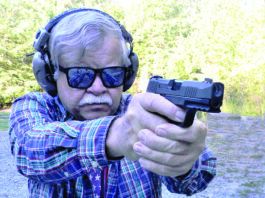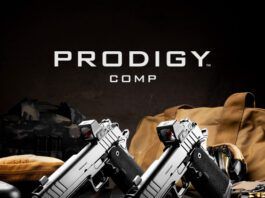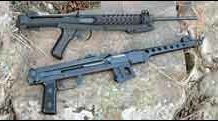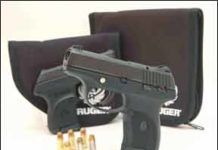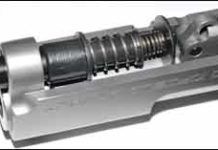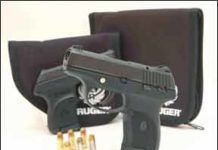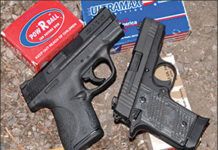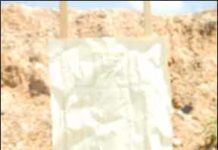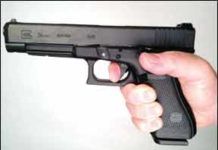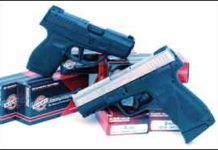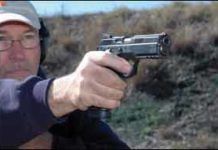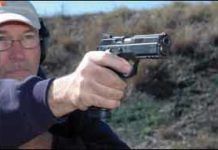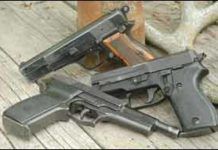Two Pieces of Firearms History: Sterling, Pioneer Arms Compete
We acquired two historical and technically interesting firearms for this test. The guns were the 9mm Wise Lite Arms Sterling L2A3 9mm, about $500, and the Inter Ordnance/Pioneer Arms PPS-43C Pistol chambered in 7.62x25 Tokarev, also in the $500 range. The latter is officially a pistol because its folding stock is welded in the folded position. We found the folding stocks do nothing for their handling or practical function, but in close quarters that might be a handy feature. Both designs originally fired from an open bolt, and the Sterling was originally selective fire. These two test guns are both manufactured to fire semiauto-only, and they both fire from a closed bolt. We managed to find three types of 9mm ammo and two brands of 7.62x25 Tokarev, enough to wring out both guns. Here's what we found.
Ruger LC380 ACP Pistol: Downsized Nine That Works
One More Nine: Springfield EMP
A couple of months ago, a third gun showed up as we were wrapping up our test of two carry 9mm Lugers, the SIG P239 and H&K's USP Compact. This was the Springfield EMP, which has a stunning MSRP of $1345. This pistol was a little smaller than the other two, and had a very simple and familiar mechanism. It was basically a small 1911 built around the 9mm cartridge. The barrel was 3.2 inches. The side of the slide was marked with a logo of the letters EMP done in a manner that left the sides of the letters off. While that was clever, we wondered what else had been left off of this small nine that maybe ought to have been there. Frankly, boys and girls, for that price there better be exactly nothing left off.
Ruger LC380 ACP Pistol: Downsized Nine That Works
Another Brace of Nines: SIGs New P938 Takes on S&W Shield
Once again we look at a pair of small 9mm Luger handguns in our ongoing search for pocket-pistol nirvana. Both of these guns are relatively new designs, and we might mention we notice a strong trend in interest in these small backup nines, which every maker now seems to have in one or more versions. This time we have the SIG Sauer P938 Extreme ($823) and the S&W M&P Shield ($449 from FullArmorFirearms.com) on our plate. We tested them with three types of ammo, Russian WPA 115-grain FMJs, Cor-Bon Pow'Rball 100 grain, and Ultramax 127-grain round-nose cast lead. We were unable to obtain any heavy-bullet ammo for this test. Ammo is scarce these days. Here's what we found.
Three-Way Handgun Showdown: Springfield, Chiappa, and Kahr
Choosing a carry sidearm is a complex task for most shooters, who must weigh power and portability, size and simplicity before spending hundreds of dollars and committing to wear a gun a good chunk of the day. Pistols usually have an edge in capacity, while revolvers have a point-and-shoot ease of use that's hard to overlook. Then there's the issue of cartridges. How much power is enough?, and how does the consumer sift the chamberings to get the most bang for his buck?
We recently tested three guns that illustrate a range of carry choices readers had inquired about, in effect pitting McIntosh and Red Delicious apples against a Valencia orange. In gun terms, our pistols were the new Springfield XD-S 45 ACP, $599, and Kahr's CM9 No. CM9093 9mm Luger, $382, going up against the Chiappa Rhino No. 200DS 357 Magnum revolver, $800. Those are counter prices from Fountain Firearms in Houston (FountainFirearms.us), where we acquired the guns.
What we wanted to find out, in particular, was whether the CCL holder had to sacrifice power (45 vs. 9mm) in order to get wear-all-day comfort, and whether a wheelgun, albeit an unusual one, could compete against subcompact pistols.
In fact, when you look at the basics other than action types, these three pretty much fit in the same box. The Rhino revolver is 6 inches long, about a half-inch longer than the Kahr (5.4 inches) and slightly shorter than the XD-S (6.3 inches). Height-wise, the Rhino checks in at 4.9 inches, a half inch taller than the XD-S (4.4 inches) and nearly an inch taller than the CM9 (4.0 inches).
But here's where power factors in. The Rhino and the XD-S clearly outdistanced the CM9 in pop, so for some shooters, having the smallest footprint in the CM9 also means shooting the weakest round, which they won't like. And, the 9mm Luger's performance is further diminished because these short handguns won't generate all the rated power of their respective rounds — there's just not enough length in the barrels. Winchester's 115-grain 9mm Luger round in the 3-inch-barrel Kahr develops average velocity/energy figures of 984 fps/247 ft.-lbs., well behind the XD-S (3.3-inch barrel, 817 fps/341 ft.-lbs.) and Rhino (2-inch barrel, 1134 fps/314 ft.-lbs.) The Fiocchi rounds showed a similar gap, except the 357 Mag was the strongest at 370 ft.-lbs., compared to 305 ft.-lbs. for the 45 ACP round and 272 ft.-lbs. for the 9mm. The power margins are little narrower for Hornady rounds because the 9mm is a +P loading, so it makes 308 ft.-lbs. of muzzle energy compared to the 45 at 360 ft.-lbs. and the 357 at 380 ft.-lbs. Also, it's worth emphasizing that the Rhino had the highest energy ratings of the trio with two of the rounds (see the accompanying accuracy/chronograph table for details).
Besides comparing the numbers, we also tested all three for accuracy at 7 yards from a benchrest. Then we tested how each would perform when drawn and fired quickly, using Hornady Critical Defense rounds for the XDS and Rhino and Hornady Critical Duty for the CM9. For this defense test we had a target 7 yards downrange on edge, programmed to turn and face the shooter for 3 seconds, then turn back to edge, with a randomized wait time before turning. Our testers had to start from low ready and fire as many shots aiming at center mass as accurately as possible in 3 seconds. The target was a Birchwood Casey silhouette splattering target with X, 10, 9, and 8 rings.
On a gun-by-gun basis, we found some things we liked and didn't like about each of the carry contestants. Here's what we thought about each one individually:
Options for Concealed Carry: Two Nines Vs. a Forty Wheelgun
When it comes to concealing a handgun, there is only so much space available on the hip, inside a handbag, or somewhere else on the body or in clothing. That's why there are snubnosed revolvers and subcompact pistols. Choosing a handgun, then, becomes a balance of firepower versus weight and overall structural dimensions. In this test, we will limit the size of our test guns to three guns that will fit into a box approximately 5-by-7 inches in size — which represents a handgun that can be carried easily in just about any manner of traditional concealment.
However, we are purposefully mixing apples and oranges, that is, pistols and revolvers, because either design can do the job of self-protection at close range. Our three test guns were the $747 9mm Kimber Solo Carry, the $299 9mm SCCY Industries CPX-2, and the $523 Taurus 40 S&W M405 stainless-steel revolver. Each gun offered at least one advantage not shared by the other two. The Kimber Solo was the most concealable. The SCCY pistol offered the highest capacity, and the Taurus revolver fired the biggest bullet.
The cartridge versus cartridge debate rages on, largely based on the stopping power of one single shot. But let us offer an alternative viewpoint suggested by TacPro Shooting Center's Bill Davison. Davison, a former Royal Marine and one of the most complete training consultants in the United States, offers that when rating the firepower of a handgun, the amount of energy it can deliver should be the sum of its entire capacity rather than the energy of one lone shot. For example, a 9+1 capacity pistol, wherein each bullet registers about 330 foot-pounds of energy at the muzzle, should ultimately be considered more powerful than a six-shot pistol that fires ammunition capable of delivering 500 foot-pounds with each round of fire. Food for thought.
For our tests, we began by shooting five-shot groups (the capacity of the Taurus) from the 15-yard bench. Then, we applied what we think was a more realistic test. Each gun was fired from a distance of 5 yards at a humanoid paper target. Start position was with the gun lowered to rest on a oil-barrel top about waist high. We used a CED8000 shot-activated timer to provide a start signal and record elapsed time of each shot. We took note of the first shot to see how fast we could get the gun into action and the last shot to see how long it took to deliver two shots to center mass and one shot to the head area. Altogether we recorded five separate strings of fire. We scored the hits A, B, C, or D, looking for ten hits to the preferred 5.9-inch by 11.2-inch A-zone at center mass and five hits to the A-zone in the head, which measured 4 inches long by 2 inches high. The catch was that the test was performed strong hand only. (By a right-handed shooter holding the gun with only his right hand). We weren't trying to be cowboys or go Hollywood. It's just that in close-range fighting where guns such as these would most likely be used, applying a support hand may not be possible. On the semiautos, there wasn't much room for a support hand in the first place.
For testing the Taurus revolver, we chose Winchester 165-grain FMJ ammunition sold in a value pack, Federal Premium 135-grain Hydra Shok JHP ammunition, and Hornady Custom 180-grain XTP jacketed hollowpoint rounds. The 165-grain rounds were also used in our action shooting test. For testing the semi-automatics, we ended up using four test rounds. After testing with 115-grain FMJ, 115-grain JHP EXP hollowpoints, and 124-grain JHP rounds from Black Hills Ammunition, we learned that Kimber had declared that the Solo should only be used with 124-grain and 147-grain bullets. So, we went back to the test range with a supply of Federal 147-grain Federal Hydra Shok ammunition and resumed our bench session. Naturally, we retested the SCCY pistol with the 147-grain ammunition as well. All test rounds were standard pressure, including the Black Hills EXP ammunition, which was designed for maximum performance in firearms not recommended for +P ammunition. Here is what we learned.
Practical Match Pistols: Pro9, P30L, and G34 Gen4 Compete
In the February 2012 issue, we tested five high-capacity semi-automatic 9mm handguns that were aimed at the Practical Shooting competitor. Practical Shooting evolved from experimentation with handguns used for self-defense. One characteristic that separates Practical Shooting from other organized pistol competition is that the scoring takes into account the amount of time it takes to deliver the required number of shots for each course of fire. So, fast-action gun handling, as well as quick, precise shots becomes an integral part of the shooter's score. In this test, we'll pay particular attention to features and components that make the guns faster and easier to operate, as well as more accurate.
Our February roster included two guns that were specifically prepared for competition by CZCustom.com of Mesa, Arizona. In this test the guns were not as specialized. But the $1108 Heckler & Koch P30L V3 is one of the guns favored by HK's official Practical Shooting team, and Smith & Wesson team shooters use the $670 M&P 9 Pro Series pistol. To date, most Glock shooters use the Gen 3 version of the G34 as tested previously. In this test we'll try using the new $649 G34 Gen 4 pistol to see what effect the Gen 4 features may have in making it a better choice for competition.
Each pistol was tested for accuracy from the 25-yard line by firing from a sandbag rest. Test ammunition was the same as used in our previous test, including new manufacture (red box) 115-grain FMJ, and 124-grain JHP rounds from Black Hills Ammunition. We also fired 147-grain flatpoint FMJ rounds from Federal American Eagle. One of our guns offered a single-action trigger, so we took advantage of this option and shot groups of record with the HK P30L single action only.
To learn more about the match potential of each pistol we set up two action tests. Our "field" course of fire was the same one used in our February test, consisting of picking the gun off a table top and firing at two IPSC Metric targets 21 feet downrange spread 15 feet apart. The shooter was centered between the two targets and the catch was that the gun was fully empty with pistol and loaded magazine lying next to each other. The shooter began with hands placed flat to either side of the gun and magazine. Upon an audible start signal from our CED8000 shot recording timer, our shooter loaded the gun, and moving from left side target to right side target, fired two shots to the center mass A-zone (a 5.9-inch-wide by 11.2-inch-tall rectangle). The shooter then reengaged from left to right but this time with only one shot to the head areas which measured about 6-inches square. Inside the head area was a 4x2-inch rectangular A-zone surrounded by B-zone values. We also carried over our "double-tap" test but with different rules. We still wanted to know how fast we could deliver a quick pair of shots, but we also wanted to know how fast the guns could be reloaded in situations where the chamber was not yet empty nor the slide locked back. We added the reload because the HK pistol utilized ambidextrous paddles rather than side-mounted buttons such as those found on our Smith & Wesson and Glock pistols. The target for this test was Caldwell's plastic-coated 8-inch Bullseye TipTop targets which overall measured 8.5x11 inches and were punched for loose-leaf storage. Figures from our double-tap test reflected the elapsed time between the first and second shot after we had raised the gun from about a 45-degree angle from the horizon. And the amount of time it took us to reload, acquire the sights and fire, then the elapsed time between the final two shots.
In addition to judging match potential, we also wanted to know how they would relate to non-competitive or beginning shooters. The good people at FortTexas.us training helped facilitate this test, and we asked them why our test guns might or might not be included in their "dirty dozen," a house collection of 12 different handguns that students are welcome to try to learn firsthand what type of pistol might fit them best. Here's what we found.
9mm Handguns Big and Small: Taurus, Walther, DiamondBack
9mm Practical Shooting Pistols: Glock, Springfield, and CZ USA
9mm Practical Shooting Pistols: Glock, Springfield, and CZ USA
Three Big 9mms: SIG Sauer P6 Does It All, at a Great Price
In a happy break from our testing of tiny 9mm handguns, we took up the mantle of trying a few that border on, or maybe exceeded the envelope of, too-big nines. We acquired a trio of surplus guns from Southern Ohio Gun, fondly known as SOG, in the form of a Croatian, a Hungarian, and a German. They were all somewhat used, but not badly abused. The guns are the PHP Model MV ($200), the FEG P9M ($260), and the Sig Sauer P6 ($350). Please note that all these older test guns are not always still available by the time we get them and test them, write it all up and get our test into print. Such was the case with at least the SIG P6 of this test. We tested the three guns with Blazer 124-grain FMJ, American Eagle 115-grain FMJ, Winchester 115-grain BEB, and with Federal 124-grain Hydra-Shok. Here is what we found.




























